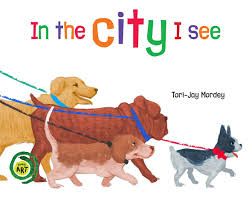
My grandmother and I catch the bus into the city for a special adventure. We’ve looked at the shops, taken in the sights, seen the buskers around Circular Quay, and topped off the day with some ice cream by the water.
These are the memories that come to mind as I read In the City I See by Tori-Jay Mordey.
A board book aimed at children from birth to early preschool (remembering that it is never too early to read with your child!) In the City I See is great for sharing or for exploring independently.
For the very young, it can be propped open during tummy time, providing visual stimulation and fostering an early appreciation for books. Toddlers will be able to manage the thick pages with their developing fine motor skills, while it is sturdily constructed to withstand rips, being chewed on and dropped from high chairs and prams.
The simplicity of the text, combined with vibrancy of the illustrations, promotes conversation about previous or future experiences. From simply encouraging your child to label what they see, to using the book as a stimulus to talk about a family excursion, this book encourages your child’s language development. The descriptive phrases expand your child’s vocabulary and this book could even be used as an aid for older children learning about the world of adjectives.
Books can help your child make connections with the world around them. Familiarity with the content is an important aspect of In the City I See. Children who have experienced the big city will be able to relate to the objects, people and experiences of the book.
Children who live rurally or who have not yet had the opportunity to explore the hustle and bustle of a CBD can also benefit from this book. Their knowledge of the world around them will be expanded as they are exposed to the concepts of tall buildings, big signs and long buses.
Featuring the artwork of Indigenous artist Tori-Jay Mordey (author and illustrator), In the City I See is a great way to initiate discussion with Indigenous and non-Indigenous children about Indigenous culture. Indigenous concepts are woven into the illustrations framed in a modern way, with bright colours and contemporary concepts. Subtle nods to traditional art making practices and music, reference to an Indigenous dance company, and the inclusion of the Aboriginal and the Torres Strait Islander flags on the top of the tall buildings provide many opportunities to further explore Indigenous culture with your child.
If you enjoyed reliving memories with your child while reading In the City I See, you may also enjoy the other books in this series: At the Beach I See (written and illustrated by Kamsani Bin Salleh) and At the Zoo I See (written by Joshua Button, Robyn Wells and illustrated by Joshua Button).




